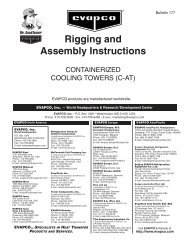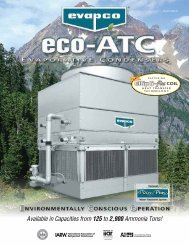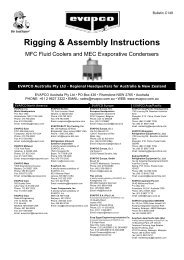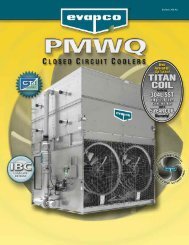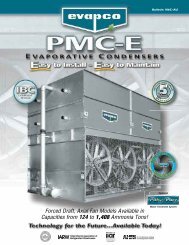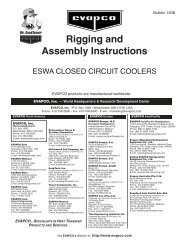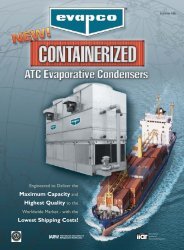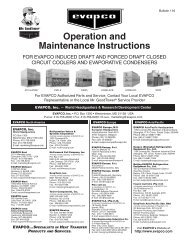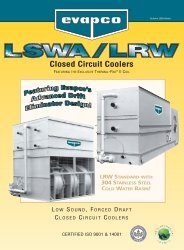For Evapco Fibreglass Cooling Towers, Closed ... - EVAPCO.com.au
For Evapco Fibreglass Cooling Towers, Closed ... - EVAPCO.com.au
For Evapco Fibreglass Cooling Towers, Closed ... - EVAPCO.com.au
Create successful ePaper yourself
Turn your PDF publications into a flip-book with our unique Google optimized e-Paper software.
Bleed or Blowdown<br />
Operation and Maintenance Instructions<br />
Evaporative cooling equipment rejects heat by evaporating a portion of the recirculated water into the<br />
atmosphere as warm, saturated discharge air. As the pure water evaporates it leaves behind the impurities<br />
found in the system’s makeup water and any accumulated airborne contaminants. These impurities and<br />
contaminants, which continue to recirculate in the system, must be controlled to avoid excessive<br />
concentration which can lead to corrosion, scale, or biological fouling.<br />
Evaporative cooling equipment requires a bleed or blowdown line, located on the discharge side of the<br />
recirculating pump, to remove concentrated (cycled up) water from the system. <strong>Evapco</strong> re<strong>com</strong>mends an<br />
<strong>au</strong>tomated conductivity controller to maximize the water efficiency of your system. Based on<br />
re<strong>com</strong>mendations from your water treatment <strong>com</strong>pany, the conductivity controller should open and close a<br />
motorized ball or solenoid valve to maintain the conductivity of the recirculating water. If a manual valve is<br />
used to control the rate of bleed it should be set to maintain the conductivity of the recirculating water<br />
during periods of peak load at the maximum level re<strong>com</strong>mended by your water treatment <strong>com</strong>pany.<br />
Galvanized Steel – Passivation<br />
‘White Rust’ is a premature failure of the protective zinc layer on hot dip or mill galvanized steel which can<br />
occur as a result of improper water treatment control during the start-up of new galvanized equipment. The<br />
initial <strong>com</strong>missioning and passivation period is a critical time for maximizing the service life of galvanized<br />
equipment. <strong>Evapco</strong> re<strong>com</strong>mends that your site specific water treatment protocol includes a passivation<br />
procedure which details water chemistry, any necessary chemical addition, and visual inspections during<br />
the first six (6) to twelve (12) weeks of operation. During this passivation period, recirculating water pH<br />
should be maintained above 7.0 and below 8.0 at all times. Since elevated temperatures have a deleterious<br />
effect on the passivation process, the new galvanized equipment should be run without load for as much of<br />
the passivation period as is practical.<br />
The following water chemistry promotes the formation of white rust and should be avoided during the<br />
passivation period:<br />
1. pH values in the recirculating water greater than 8.3.<br />
2. Calcium hardness (as CaCO3) less than 50 ppm in the recirculating water.<br />
3. Anions of chlorides or sulfates greater than 250 ppm in the recirculating water.<br />
4. Alkalinity greater than 300 ppm in the recirculating water regardless of pH value.<br />
Changes in water chemistry control may be considered after the passivation process is <strong>com</strong>plete as<br />
evidenced by the galvanized surfaces taking on a dull gray colour. Any changes to the treatment program<br />
or control limits should be made slowly, in stages while documenting the impact of the changes on the<br />
passivated zinc surfaces.<br />
• Operating galvanized evaporative cooling equipment with a water pH below 6.0 for any period may<br />
c<strong>au</strong>se removal of the protective zinc coating.<br />
• Operating galvanized evaporative cooling equipment with a water pH above 9.0 for any period may<br />
destabilize the passivated surface and create white rust.<br />
• Repassivation may be required at any time in the service life of the equipment if an upset condition<br />
occurs which destabilizes the passivated zinc surface.<br />
<strong>For</strong> more information on passivation and white rust please request a copy of Engineering Bulletin #36 from<br />
your local <strong>EVAPCO</strong> representative.<br />
Page 22 of 34 www.evapco.<strong>com</strong>.<strong>au</strong> sales@evapco.<strong>com</strong>.<strong>au</strong>



